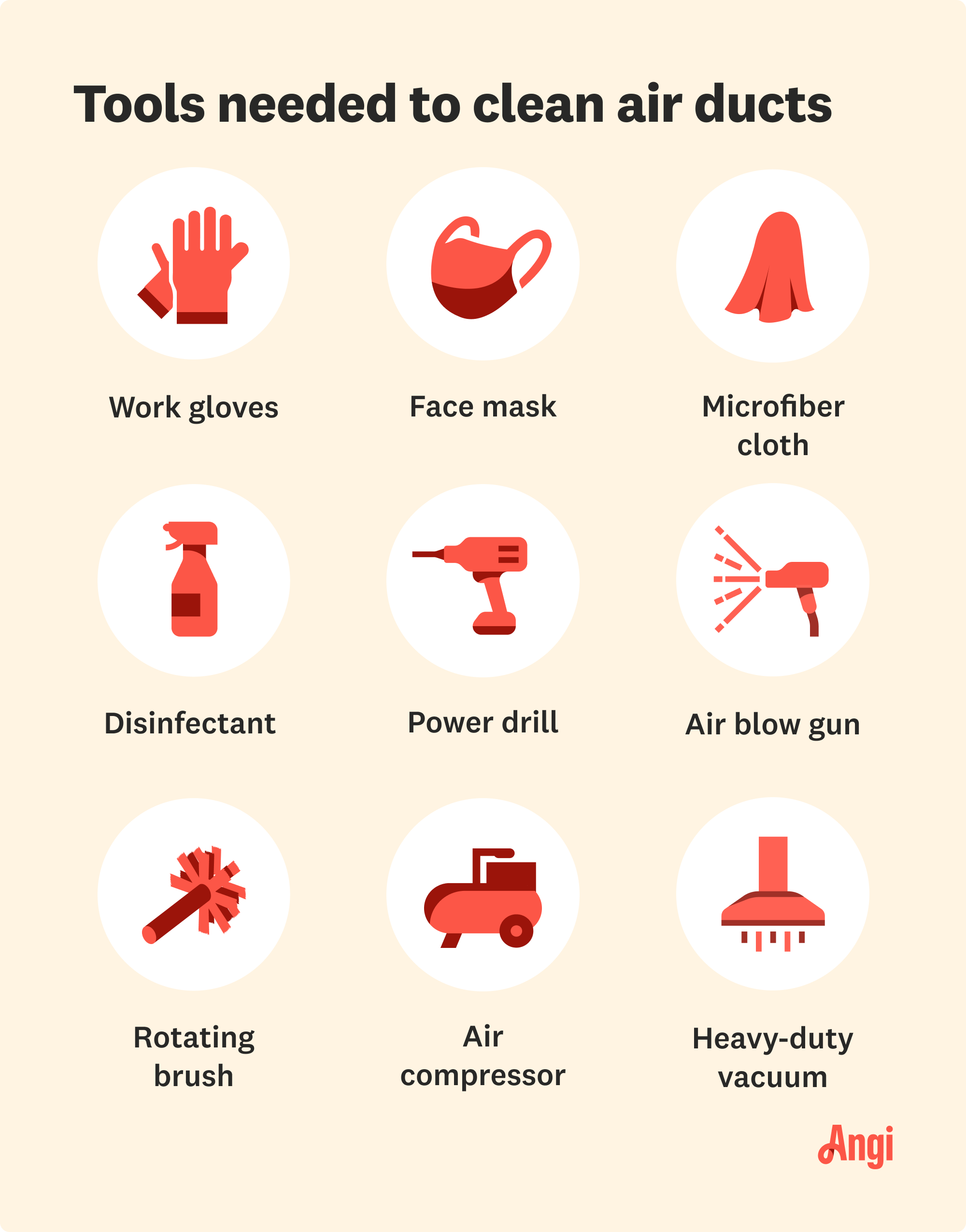10 Tips for Better Electric Furnace Maintenance
Keep your home toasty warm with some simple furnace maintenance tasks


Make sure your heating system stays at peak efficiency with our top electric furnace maintenance tips. Aside from quick and easy monthly cleaning, you can optimize furnace performance and save on repairs by changing the air filters, lowering the thermostat, and having a pro complete annual inspections.
1. Clean Out the Access Panels
In the fall, just before you use your furnace regularly, remove all the dirt, dust, and debris that builds up in the access panels with a vacuum and a long attachment. In an ideal world, do it twice a year—once in the fall and the spring.
2. Clean the Fan and Motor
While cleaning the inside of the furnace via the access panels, take the time to run your vacuum over the motor and fan. Wipe the fan blades (if accessible) with an anti-static cloth.
3. Replace the Air Filter

Staying on a schedule to change the air filters every three months helps maximize efficiency and minimize energy costs. Replacing filters is a quick and easy job that reduces strain on the furnace.
If your furnace is on most of the time, your household likely generates a lot of dust. If you have a family member sensitive to airborne allergens, changing the air filters every month is a good idea. You can also check how long your filters last by reading the instructions.
4. Clean the Air Ducts
Once a month, get your vacuum with the trusty long nozzle attachment and clean your air ducts. Simply remove the duct covers and vacuum inside the cavity. This gets rid of dust, dirt, and bug fragments. There are many advantages to cleaning the ducts monthly, including reducing allergens and eliminating foreign particles that can cause an obstruction.
The Environmental Protection Agency states, "Indoor pollution sources that release gases or particles into the air are a primary cause of indoor air quality problems in homes.” Cleaning the ducts regularly removes potentially harmful particles, but you’re more likely to spot something detrimental to your family's health, such as mold, and get it under control as soon as possible.
You can also opt to have your air ducts cleaned by a professional every three to five years.

5. Have Yearly Inspections
It’s important to have your furnace inspected and serviced annually to keep it in good working order. Yearly inspections usually include a basic tune-up to optimize your furnace performance. Additionally, your local HVAC technician will spot any minor issues and fix them before they become serious.
A furnace inspection costs $60 to $85 on its own, but you can get it as part of an HVAC service contract, an excellent way to save money on heating and cooling inspections.
"As a professional, I'd never miss out on routine servicing for my heating system. It's really easy to skip servicing your unit, but it can lead to breakdowns and high energy bills. It can be a safety issue, too."
— Yashar Mosaferi, President of Klondike AC, British Columbia, Canada
6. Reduce the Temperature
You might have to wear a sweater, but turning the temperature on your thermostat down by a degree or two can save you costs on your energy bill and reduce the strain on your furnace. The US Department of Energy states that lowering the thermostat by 7 to 10 degrees for the eight hours you're asleep can save you up to 10% on your annual heating bill.
You can further optimize your thermostat settings by upgrading your regular thermostat to a learning model. These units are programmable and smart, so they can learn your routine and turn themselves down when nobody's home.
7. Upgrade Your System
If you pay multiple electric furnace repair bills yearly and your energy bills are climbing, it could be time to upgrade. Older units may only be at 55% to 70% efficiency. Modern electric furnaces are up to 98.5% efficient, so upgrading to a newer model is sometimes worth reducing your home’s carbon footprint and saving on energy bills.
Depending on where you live, you may also be entitled to rebates and incentives to reduce the cost of replacing your furnace. If you're unsure whether you should upgrade your system, what your best options are, or what incentives and savings are available in your area, consult a nearby HVAC installer who can advise you.
"It's worth spending a bit more money up front to get an HVAC system that is really efficient and reliable. High-efficiency heating will save money over time and decrease your impact on the environment."
— Yashar Mosaferi, President of Klondike AC, British Columbia, Canada
8. Humidifier Maintenance
Whole-house humidifiers connect to your furnace, regulating humidity and improving air quality in your home. If you have one, cleaning and maintaining it properly is important. Otherwise, you might have mold and mildew inside your humidifier, which could spread to your ductwork.
There are several kinds of whole-house humidifiers, each with different maintenance requirements. For example, drum humidifiers require filter replacements about once per month, which cost between $10 and $20. Flow-through humidifiers, on the other hand, don’t need filter changes as frequently. But regardless of which type you have, you should have it serviced annually.
It’s also essential to monitor the moisture levels in your home. Aim for an indoor humidity level between 30% and 50% to prevent mold and mildew growth.
9. Check Heating Elements
In an electric furnace, electric currents pass through the heating elements, which creates heat and warms the air that circulates through your home. If these elements don’t work, you won’t have heat—so it’s wise to check them as part of your electric furnace maintenance routine.
Over time, your heating elements can wear down, burn out, and stop functioning. Sometimes, they can corrode and develop cracks. If one (or more) of your heating elements appear worn or won’t turn on, call a local furnace maintenance pro to diagnose and fix the problem.
10. Ensure Thermostat Is Working Correctly
Your thermostat is a pivotal part of your HVAC system, letting you control when your heating turns on, how long it runs, and how warm it gets in your home. Furnace maintenance involves ensuring that yours has fresh batteries and looking for signs of a broken thermostat.
Common problems include a thermostat that won’t maintain its programmed settings, warm your home to the correct temperature, or complete an entire heating cycle. If you notice any of these issues, contact an HVAC pro for help.
Frequently Asked Questions
For one, your electric furnace needs an annual inspection by an HVAC professional. On top of that, you should also clean out the access panels twice yearly, swap out the air filters every three months, and vacuum your ducts once monthly. In the winter, you can ease the strain on your furnace by reducing the temperature by a couple of degrees.
You should hire a pro to clean and inspect your electric furnace at least once per year. It’s also smart to lightly clean your furnace and other parts of your HVAC system in between service appointments. This includes removing dust from the fan and motor, wiping down the blades, and cleaning out the access panels.
Yes, you have to clean electric furnaces. They might not require as much upkeep as gas furnaces, but electric furnaces still collect dust, dirt, and debris—and if you don’t get rid of it, all of that gunk and grime can get into your air ducts and wear down your HVAC system. Not sure how to clean an electric furnace? At your next service appointment, ask your technician to walk you through it.





- Furnace Repair
- Air Conditioning Repair
- HVAC Repairs
- Furnace Installation
- Wood & Pellet Stove Repair
- Dehumidifier & Humidifier Repair
- Heat Pump Companies
- Swamp Cooler Repair
- Wood Stove Services
- HVAC Companies
- Commercial A/C Repair
- Geothermal Installation
- Air Conditioning Installation
- Boiler Repair
- 24 Hour Furnace Repair
- Geothermal Repair
- Heat Pump Repair
- Humidifier Installation
- Thermostat Repair
- Thermostat Installation
- Nest Installation
- Heating & Cooling
- Heating Repair
- Furnace Cleaning
- Furnace Tune-Up
- HVAC Technicians
- Subcontractors
- Furnace Maintenance
- Plumbing & Heating Companies
- Wood Stove Inspection
- Mini Split Installation
- Wall Heater Repair
- Duct Installers
- 16 Furnace Maintenance Tips to Keep Your Home Cozy All Season Long
- 10 Furnace Troubleshooting Tips: How to Fix Any Heating Issue
- Why Is My Furnace Not Keeping Up With Cold Weather?
- Your Complete Gas Furnace Inspection Checklist
- How Long Do Furnaces Last and How Can I Extend the Life Span of Mine?
- What Does a Furnace Do and How Does It Work With Air Conditioning?
- 8 Furnace Safety Tips Every Homeowner Should Know
- How to Know If You Should Repair or Replace Your Furnace
- What Is a Furnace and How Is It Different From Other Heating Systems?
- 6 Signs of Furnace Problems















